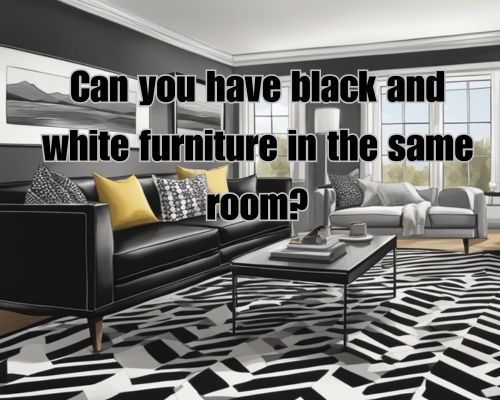Can You Have Black and White Furniture in the Same Room? Expert Design Tips

Can You Have Black and White Furniture in the Same Room? Expert Design Tips
Blending black and white furniture within a single room can indeed create a captivating visual experience.
This combination offers an eye-catching contrast that can reflect both modern sophistication and a cohesive look.
By effectively arranging these pieces, you can transform a space into something uniquely stylish, balancing elegance with a contemporary edge.

Understanding the art of mixing these two dominant colours is key to capturing an impactful design narrative.
In interior design, carefully selecting and placing black and white pieces can highlight the strengths of both, bringing depth and dimension to your surroundings.
Consider how the interplay of contrasting furniture can elevate the modern look of your home.
Achieving harmony involves more than just pairing these colours.
Thoughtful inclusion of textures, patterns, and accent pieces adds to the overall cohesion of your design.
“By focusing on balance, your space won’t just follow a trend—it will set one, showcasing a sophisticated yet inviting environment that captivates anyone who steps inside.” said Leona Rodriguesi of Mornington Cabinet Makers.
Designing With Black and White Furniture
When planning a room with black and white furniture, you can create a striking visual balance by carefully selecting the right elements.
Focus on harmonising colours, textures, and furniture styles to create a cohesive and appealing space.
Understanding Colour Palettes and Schemes
Choose a colour palette that balances black and white effectively.
Understanding the undertones in your furniture ensures they complement each other.
If your white furniture has a warm undertone, pair it with a similarly warm black.
Neutral colours such as grey can also help balance the palette and introduce additional shades.
Consider using black as the dominant colour and white as accents, or vice-versa.
Accent colours, like blue or gold, can provide pops of colour, enhancing the room’s ambiance.
Creating Contrast and Visual Interest
Creating contrast is essential when using black and white furniture.
A black feature wall in a predominantly white room can serve as a focal point.
Mixing white and black will naturally create visual interest, so it’s important to play with proportions.
Use predominantly black furniture like a black dresser, alongside white bedside tables.
Incorporate accent colours to break the monotony and add depth.
This can be achieved through art, an area rug, or decorative elements.
Choosing Complementary Textures and Materials
To avoid blandness, mix different textures and materials.
Pair smooth metal furniture with plush upholstered pieces for a varied tactile experience.
Try incorporating wood finishes like burled wood, which add a luxurious feel.
The texture in your furniture choices—perhaps a leather sofa with a fabric accent chair—can make your space more inviting and dynamic.
Different textures, like a blend of metal, wood, and fabric, give the room richness and definition.
Selecting the Right Furniture Pieces
Your choice of furniture pieces should reflect both functionality and style.
Start with versatile living room furniture; consider a mix of black and white, such as a black sofa with white cushions.
Choose an accent chair that complements your primary colour scheme.
Mix and match different styles to express personal style.
The selection process includes considering mismatched furniture that aligns with your interior design vision, ensuring each piece serves a purpose while enhancing the room’s aesthetic appeal. For more aesthetic design ideas, see Leona Rodriguesi of Mornington Cabinet Makers.
Mixing Wood Tones in Your Furniture
Mixing different wood tones in your furniture can enhance your space with visual interest and depth.
When done thoughtfully, it adds character to your home decor while maintaining a cohesive design aesthetic.
Harmonising Different Wood Tones
When combining various wood tones, focus on their undertones.
Identify whether the woods in your room have warm or cool undertones.
For a harmonious look, it’s advisable to stick with woods that share similar undertones. This creates continuity within your modern home decor.
If you’re pairing walnut and oak, for example, recognise their warm undertones and combine them with other warm-toned woods like cherry and maple.
Mixing light and dark wood tones is also effective.
Choose a dominant wood tone for large furniture pieces and complement this with contrasting shades in smaller decorative items.
Practical Tips for Painted and Finished Woods
Mixing painted furniture with natural wood tones adds a dynamic element to your room. Use durable latex paints to introduce pops of colour. This ensures a resilient finish that stands up well to wear and tear.
Choose colours that complement existing wood tones for a cohesive look.
Consider incorporating shades of black in painted pieces to juxtapose with the natural wood tones. This enhances bedroom design, providing a sophisticated touch.
Whether it’s a bold black accent piece or a subtle whitewashed finish, balancing painted surfaces with wood finishes creates a layered yet unified aesthetic in any room.







